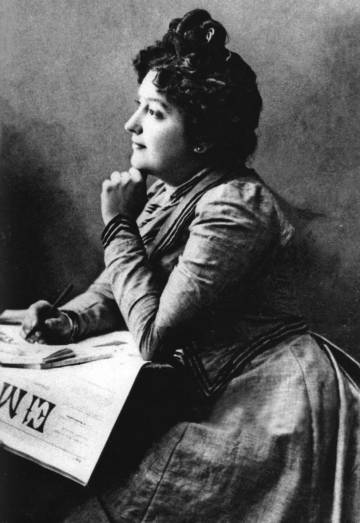Spain’s forgotten female war correspondent
Carmen De Burgos ignored social mores to become a prominent writer of the early 20th century

Carmen de Burgos also known as 'Colombine', circa 1901. COMPANY
“Too little time has passed since the death of Carmen de Burgos for us to sincerely judge the magnitude of her work. I hope and trust that some day, the historic and social value of this great woman will be understood,” wrote Concha Peña in the Heraldo de Madridon October 14, 1932, just five days after the writer had died.
Peña’s wishes fell on deaf ears. Nothing of the sort happened. At the end of the Second Republic, Carmen de Burgos, better known by her nom de plume Colombine, was buried, silenced, and all other related synonyms as part of a very effective mission to erase the story, works and legend behind one of the most important writers of the early 20th century, the first female staff reporter and Spain’s first female war correspondent (whose name remains completely unfamiliar in most newsrooms).
De Burgos wrote more than 100 short stories, dozens of novels, essays and translations, and nearly 10,000 news stories
Carmen de Burgos (1867-1932) was born 150 years ago in Rodalquilar, in Almeria province, on December 10. She married Arturo Álvarez Busto, a journalist 12 years her senior, but it was an “insufferable” marriage, according to her autobiography. Her husband’s only contribution was an understanding of journalism and a daughter, the only child of four to survive past their first year of life. She would later find love with Ramón Gómez de la Serna, an avant-garde Spanish poet 21 years her junior, with whom she spent two decades of her life.
At the turn of the 20th century, De Burgos’s life changed. At a time when women could do nothing without the approval of their husbands and were barely in control of their own lives, she left her husband, passed teaching examinations and moved with her child to Madrid.
In the capital, she was very clear about what she wanted: to be part of the intellectual movement, to talk about ideas with the city’s most prominent thinkers and writers, and to write – more than anything else – to write. And in this she succeeded. She surrounded herself with the likes of Benito Pérez Galdós, a leading literary figure of the 19th century, Emilia Pardo Bazán, a writer and tireless advocate for women’s rights, and Gregorio Marañón, a notable Spanish historian and philosopher. She even maintained correspondence with Nobel laureate Juan Ramón Jiménez.
Over 300 works from her time as a journalist are set to be published next year
De Burgos shared their concern for where the country was headed, but she gave a woman’s point of view on the issue. Before the concept even existed, she wrote from a gender perspective, drawing attention to society’s patriarchal power structures. She knew how important it was that her work was reaching readers. One of her first news reports was about children in prison. That was just the beginning of what would be an enormous body of work: more than 100 short stories, dozens of novels, essays and translations, and nearly 10,000 news stories.
Around 300 of her works are now set to be published by Concepción Núñez Rey, a retired professor from the Spanish Studies Department at the Complutense University of Madrid who has dedicated her life to Colombine. Núñez Rey will present the works in two volumes in celebration of the 150th anniversary of De Burgos’s birth. The National Library has also organized a small exhibition in her honor, and the cultural center Ateneo de Madrid will showcase her book covers in a special display until the end of the year.
One woman, many names
The library exhibition is named after one of the many names the author was known by: The red lady. It’s a decision that has upset the scholar Núñez, given that it was used as an insult by De Burgos’s detractors, especially those from the Catholic Church. “It was a way for her ideological adversaries to belittle her. They couldn’t forgive a woman for breaking so many molds,” says Núñez.
They also called her The Divorce-maker after she published Divorce in Spain (in 1904!) in which she collected the conclusions of the experts she consulted on the need for a law to regulate the end of marriages in one of her columns for Diario Universal. De Burgos signed these columns as Colombine, which soon became the name she was best known by. Between 1917 and 1922, it’s said that she used the pseudonym Perico el de los palotes, a proverbial term akin to Joe Blow, for her book reviews in the Heraldo de Madrid, a newspaper that took her on as a foreign correspondent in 1905.
In 1909, De Burgos covered the war in Melilla, on the northern coast of Africa, between Spanish troops and Rif tribes, describing not only the conflict but the everyday life of the soldiers. She fought – quite possibly literally – against a hostile newsroom, speaking out against the death penalty, in favor of women’s suffrage, about the conditions of the country’s most disadvantaged workers, and revealing what she had discovered on her trips through Europe and the Americas.
Her desire to live on her own terms and her support for social progress made her a pioneer in many fields, including the one that deleted her name from the annals of history: Carmen De Burgos was the first woman to show up on the list of forbidden authors under Franco.
English version by Melissa Kitson.






















No hay comentarios:
Publicar un comentario